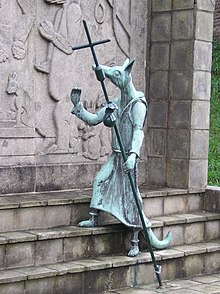Van den vos Reynaerde

Van den vos Reynaerde is the title of an animal poem in central Dutch in verse that tells of a clever fox. It was created in the 13th century and, as Reynaert's history , was revised and expanded in the 14th century, which became increasingly popular in Europe as Reynke de vos through book printing . The original epic is referred to in research as Reynaert I , the revision as Reynaert II .
content
In a foreword to the epic Van den vos Reynaerde , a Willem speaks out as the author, who notes another work, Madock , as his; however, this work was never known.
Willem tells of a court day of King Nobel, the lion, to which only Reynaert, the fox, did not appear. The animals present bring legal action against the fox, above all Ysegrym, the wolf. The fox is summoned by messengers Brun, the bear, and Tybeert, the cat; they are maliciously duped by the fox and put their lives in danger. Only Grymbert, the badger, manages to bring Reynaert to the farm. Reynaert is sentenced to death, but is able to save himself in dire need by inventing a story in a final confession in which Brun and Ysegrym appear as traitors; to back it up, he even blackens his own father for stealing treasure to aid the traitors. Nobel believes him and has the bear and the wolf imprisoned. Reynaert pretends to make a pilgrimage to Rome, accompanied by Belin, the ram, and Cuwaert, the hare. Reynaert eats the hare at the first opportunity, unnoticed by Belin, and sends the unsuspecting ram with Cuwaert's head in the satchel back to the yard. After the betrayal is discovered, Brun and Ysegrym are rehabilitated, Belin is declared outlawed and Reynaert is given eight .
This story was edited and expanded a good hundred years later by an unknown editor and recorded as Reynaert's history . In the continuation of Willems' story, Reynaert is summoned again, this time on the occasion of a court festival at which another lawsuit is brought against him, and brought to the court by Grymbert. In contrast to the serious accusation of treason, the fox fables his earlier story of lies by painting objects of the hidden treasure and thus, similar to the first part, is able to beguile the king and in particular portray Ysegrym as a crook; He finds support in Rukenau, the monkey who defends him. Ysegrim now leads the rape of his wife Gyremod in the field and challenges Reynaert to a duel. The fox, physically inferior, is skillfully groomed by the monkey and can assert itself in the duel. Nobel appoints him to his throne councilor.
origin
The epic Van de vos Reynaerde shows origins from the ancient fables of Aesop , from the Ysengrimus , originated in the Ghent area in the 12th century , and in particular from the Roman de Renart , an episodic collection of animal stories, originated in the 12th century in northern France, which illuminate courtly life parodistically .
Lore

Van den vos Reynaerde , listed as Reinaert I , is completely preserved in two manuscripts. One, the so-called Dyck's manuscript , originated around 1375 in the Utrecht area , is in the possession of the University and State Library of Münster (NR 381); the other, the Comburg manuscript , made between 1380 and 1425, is held by the Württemberg State Library in Stuttgart (Cod. poet. et philol. fol. 22). The only surviving manuscript of Reynaert's history or Reynaert II is in the Royal Library in Brussels (14601); it was created around 1460–1480.
The Reynaert II was already in the early period of printing printed several times in the Netherlands, by Gerard Leeu in Gouda 1479 under the title Reynaert history van the vos and as commented prose version, again printed by Leeu, 1487-1490 in Antwerp . A reprint of the Gouda edition by Jacob Jacobsz van de Meer appeared in Delft in 1485. In the 17th and 18th centuries the work was further printed in the Netherlands; some have been banned and the conditions confiscated. Van den vos Reynaerde and its extension are now part of the Dutch national literature . There is a Reynaert monument in the town of Hulst , which is mentioned in the epic .
The prose version was printed by William Caxton in 1481 as The History of Reynard the Fox in an English translation. In 1498 a translation in Low German verse appeared in Lübeck : Reynke de vos , which has been preserved to this day as Reineke Fuchs .
literature
- Carl Wieszner: About some German legal antiquities in Willems poem van den vos Reinaerde . Grass, Barth & Co., Breslau 1891 ( digitized version )
- Amand Berteloot / Loek Geeraedts (eds.): Reynke de Vos - Lübeck 1498. On the history and reception of a German-Dutch bestseller . Münster: Lit 1998 (Netherlands Studies, Kleiner Schriften 5) ISBN 3-8258-3891-9
Individual evidence
Web links
- Digital version of Dyck's handwriting , ULB, Münster
- Digitized version of the Comburg manuscript , WLB, Stuttgart
- Reynaert I - Text edition of the Institut voor Nederlandse Lexikologie (ed .: J. Jannsens, R. van Daele, V. Uyttersprot)
- Reynaert II ( Reinaerts Historie ) - text edition of the Institut voor Nederlandse Lexikologie (ed .: W. Gs. Hellinga)